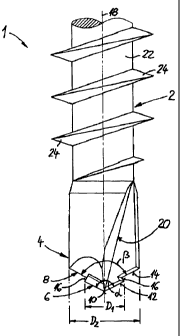Some of the information on this Web page has been provided by external sources. The Government of Canada is not responsible for the accuracy, reliability or currency of the information supplied by external sources. Users wishing to rely upon this information should consult directly with the source of the information. Content provided by external sources is not subject to official languages, privacy and accessibility requirements.
Any discrepancies in the text and image of the Claims and Abstract are due to differing posting times. Text of the Claims and Abstract are posted:
| (12) Patent: | (11) CA 2286740 |
|---|---|
| (54) English Title: | SELF-DRILLING AND THREAD-FORMING CONNECTING ELEMENT |
| (54) French Title: | ELEMENT DE FIXATION AUTOPERFORANT ET AUTOTARAUDEUR |
| Status: | Deemed expired |
| (51) International Patent Classification (IPC): |
|
|---|---|
| (72) Inventors : |
|
| (73) Owners : |
|
| (71) Applicants : |
|
| (74) Agent: | SMART & BIGGAR |
| (74) Associate agent: | |
| (45) Issued: | 2004-06-08 |
| (86) PCT Filing Date: | 1998-04-14 |
| (87) Open to Public Inspection: | 1998-10-22 |
| Examination requested: | 2000-08-11 |
| Availability of licence: | N/A |
| (25) Language of filing: | English |
| Patent Cooperation Treaty (PCT): | Yes |
|---|---|
| (86) PCT Filing Number: | PCT/EP1998/002164 |
| (87) International Publication Number: | WO1998/046891 |
| (85) National Entry: | 1999-10-15 |
| (30) Application Priority Data: | ||||||
|---|---|---|---|---|---|---|
|
The present invention relates to a
self-drilling and thread-forming connecting element, in
particular a screw (1), having a threaded shank (2) and
a drilling point (4) at the end for the chip-forming
drilling of a core hole for the threaded shank (2). The
drilling point (4) is designed as a step drill having
at least two drilling steps (6, 8) with different
diameters (D1, D2).
La présente invention porte sur un élément de fixation autoperforant et taraudeur, en particulier une vis (1) dotée d'une tige filetée (3) et d'une extrêmité en forme de pointe perforeuse (4) pour percer un avant-trou par enlèvement de matière, destiné à la tige filetée (2). La pointe perforeuse (4) est conçu comme un foret étagé comprenant au moins deux étages (6, 8) de diamètres différents (D1, D2).
Note: Claims are shown in the official language in which they were submitted.
Note: Descriptions are shown in the official language in which they were submitted.

For a clearer understanding of the status of the application/patent presented on this page, the site Disclaimer , as well as the definitions for Patent , Administrative Status , Maintenance Fee and Payment History should be consulted.
| Title | Date |
|---|---|
| Forecasted Issue Date | 2004-06-08 |
| (86) PCT Filing Date | 1998-04-14 |
| (87) PCT Publication Date | 1998-10-22 |
| (85) National Entry | 1999-10-15 |
| Examination Requested | 2000-08-11 |
| (45) Issued | 2004-06-08 |
| Deemed Expired | 2018-04-16 |
There is no abandonment history.
| Fee Type | Anniversary Year | Due Date | Amount Paid | Paid Date |
|---|---|---|---|---|
| Application Fee | $150.00 | 1999-10-15 | ||
| Registration of a document - section 124 | $100.00 | 2000-02-28 | ||
| Maintenance Fee - Application - New Act | 2 | 2000-04-14 | $50.00 | 2000-04-12 |
| Request for Examination | $200.00 | 2000-08-11 | ||
| Maintenance Fee - Application - New Act | 3 | 2001-04-16 | $50.00 | 2001-03-15 |
| Maintenance Fee - Application - New Act | 4 | 2002-04-15 | $100.00 | 2002-03-14 |
| Maintenance Fee - Application - New Act | 5 | 2003-04-14 | $150.00 | 2003-02-07 |
| Maintenance Fee - Application - New Act | 6 | 2004-04-14 | $200.00 | 2004-03-11 |
| Final Fee | $300.00 | 2004-03-23 | ||
| Maintenance Fee - Patent - New Act | 7 | 2005-04-14 | $200.00 | 2005-02-24 |
| Maintenance Fee - Patent - New Act | 8 | 2006-04-14 | $200.00 | 2006-02-21 |
| Maintenance Fee - Patent - New Act | 9 | 2007-04-16 | $200.00 | 2007-03-08 |
| Maintenance Fee - Patent - New Act | 10 | 2008-04-14 | $250.00 | 2008-03-07 |
| Maintenance Fee - Patent - New Act | 11 | 2009-04-14 | $250.00 | 2009-03-16 |
| Maintenance Fee - Patent - New Act | 12 | 2010-04-14 | $250.00 | 2010-03-19 |
| Maintenance Fee - Patent - New Act | 13 | 2011-04-14 | $250.00 | 2011-03-09 |
| Maintenance Fee - Patent - New Act | 14 | 2012-04-16 | $250.00 | 2012-03-21 |
| Maintenance Fee - Patent - New Act | 15 | 2013-04-15 | $450.00 | 2013-03-19 |
| Maintenance Fee - Patent - New Act | 16 | 2014-04-14 | $450.00 | 2014-03-12 |
| Maintenance Fee - Patent - New Act | 17 | 2015-04-14 | $450.00 | 2015-04-09 |
| Maintenance Fee - Patent - New Act | 18 | 2016-04-14 | $450.00 | 2016-03-23 |
Note: Records showing the ownership history in alphabetical order.
| Current Owners on Record |
|---|
| A-Z AUSRUSTUNG UND ZUBEHOR GMBH & CO. KG |
| Past Owners on Record |
|---|
| DICKE, ROBERT |